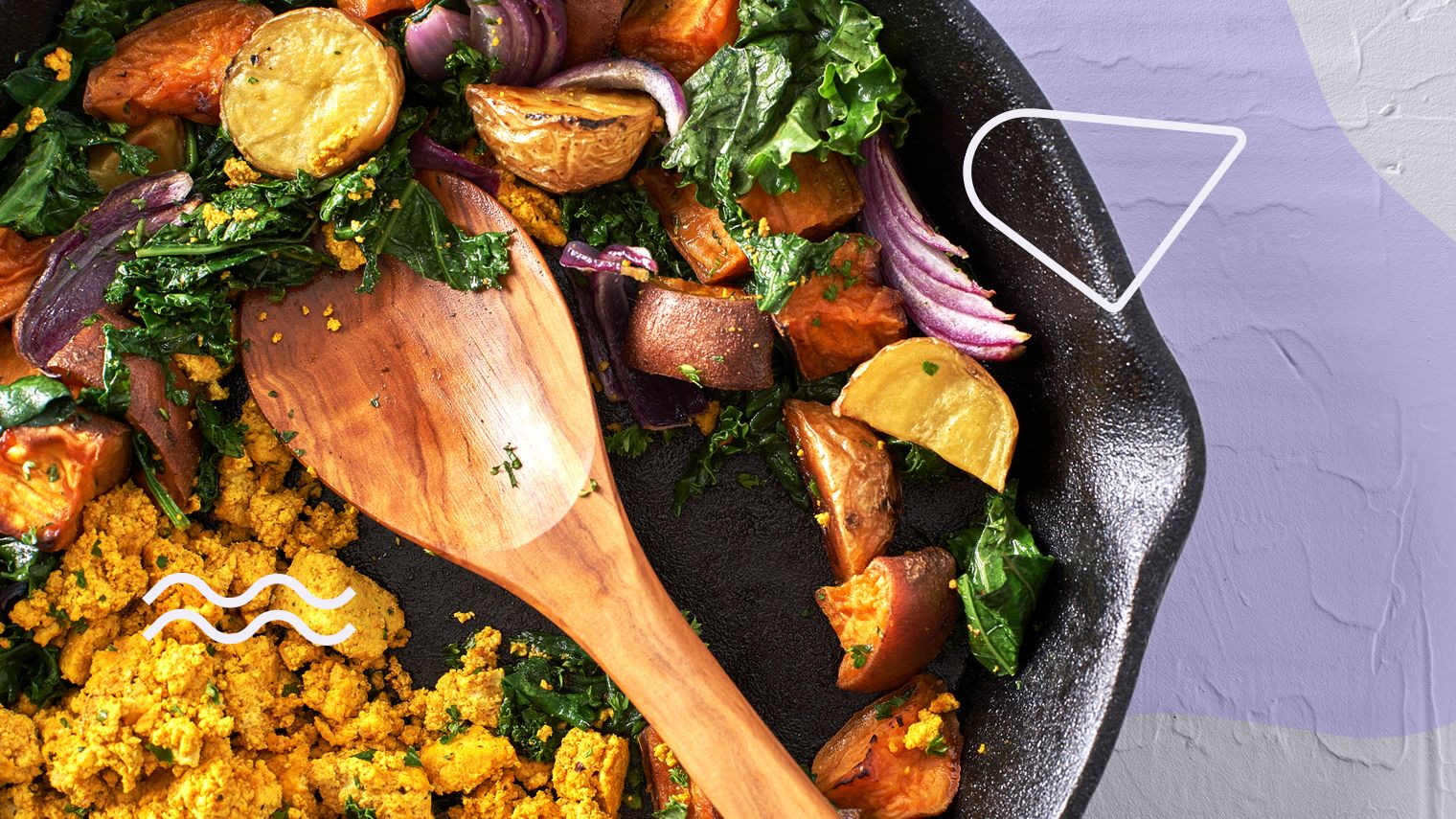7 Tips for Reducing Your Meat Consumption with IBD
March 11, 2022
Content created for the Bezzy community and sponsored by our partners. Learn More

Design by Viviana Quevedo; Photography by SKC/Stocksy United
Keep an eye on nutrition while managing your symptoms.
Eating more healthfully is on many people’s to-do list at the start of a new year. Nearly a quarter of the U.S. population is on a mission to eat less meat, either for a healthier planet, a better diet, or both. This might be something you’ve considered to help manage your inflammatory bowel disease (IBD), too.
While research hasn’t yet proven whether any specific dietary choice directly causes IBD, a 2020 survey of more than 200 British healthcare professionals found that 36 percent of them believe red meat is problematic for people with IBD. Similarly, a 2016 survey found that 18 percent of people with Crohn’s disease (CD) and 5 percent of people with ulcerative colitis (UC) — two types of IBD — avoid meat, while 8 percent of those with CD say it’s a trigger for them. A trigger food can cause symptoms, like diarrhea and bloating, to worsen. That’s the case for me so I personally don’t eat any red meat.
Yet cutting back on meat can be tricky for those of us with IBD, since meat replacements like legumes, nuts, and seeds can be high in fiber, which can worsen symptoms during an IBD flare. In addition, meat replacements tend to have lower iron concentrations than true meats, so eating them frequently can put some people at risk of developing iron-deficiency anemia. This can also be true of packaged “faux meat” products, though they vary considerably, so it’s always best to check the ingredients and nutrition facts labels.
It’s also important to note that having IBD doesn’t have to mean you need to cut back on your meat intake, since dietary triggers for IBD are different for everybody. However, if you’ve decided to try decreasing your meat consumption, keep these tips in mind for managing the transition.


1. Bring in the experts
One of the best pieces of advice I can share when it comes to any diet change is to always consult a registered dietitian first. A lot of the health advice we read is generic — whether that’s eating five servings of produce a day or hitting a daily target of 30 grams of fiber daily — but it doesn’t take into account your body and your condition.
Working with a dietitian means you will be able to tailor a diet plan to your unique nutritional needs. Ask your medical team for a referral.
2. Take notice of nutrients
Many of us with IBD are already at risk of nutritional deficiencies, due to several factors, including malabsorption of nutrients. Digestive issues and medications may cause a decrease in appetite, leading to reduced food intake. And if we have many foods that trigger symptoms, then these dietary restrictions can also reduce how much food we eat. Some of the most common micronutrient deficiencies among people with IBD include iron and vitamin B12.
While it’s not impossible to get all the nutrients you need from a diet free of red meat, it does require mindful meal planning. Since red and white meat are both good sources of iron and vitamin B12, cutting them out suddenly without support can put you at risk of developing a deficiency.
For me, avoiding meat felt like a catch-22: Red meat is one of my trigger foods, causing me stomach pain, so I eliminated it from my diet; but my iron levels would eventually fall as a result, and my doctor would recommend eating more red meat! Of course, there’s no way of knowing for sure that my anemia was a direct result of my diet change — it can also be caused by the inflammatory nature of IBD itself.
Consider working with a registered dietitian to get help incorporating other food sources rich in iron and B12, like chicken, seafood, fortified cereals, and tofu into your diet to make sure you are not at risk for developing a deficiency.
Getting regular blood tests to ensure you’re not deficient in these or other nutrients can also be a good idea. I personally get these levels checked every three months, at my doctor’s recommendation. I’ve also added a high quality multivitamin into my diet to offset any potential nutrient shortages. I suggest talking with your doctor about how often you should have bloodwork done to check for any deficiencies, and whether they recommend a multivitamin or other dietary supplements for you.
3. Monitor your fiber intake
Fiber is another frequent dilemma. High fiber foods often cause me (and others) stomach pain and diarrhea during a flare, so I have to be really strict about my fiber intake during those times; anything more than 5 g per portion is usually an issue for me. On the other hand, recent thinking concludes that dietary fiber actually can be beneficial in helping to heal the gut during remission or during a mild to moderately active disease state. As with most things, moderation seems to be key.
When I need to monitor my intake, I check every meat-free alternative that I buy for its fiber level. A lot of protein swaps — such as lentils, vegetables, and seeds — are really high in fiber, and many veggie-based burgers and sausages rely on these sources. I try to avoid these and instead opt for alternatives made with soy, tofu, or pea protein, since they tend to be slightly lower in fiber.
Another good option is protein powder. A few times a week, I’ll add some low fiber pea protein powder to my smoothie for a delicious meat- and dairy-free protein boost.
4. Consider your microbiome
We all have beneficial bacteria living in our gut, in an environment known as the gut microbiome. People with IBD seem to have less diversity in the “good” bacteria present in their microbiome, which results in an inflammatory response. Correcting this imbalance has been shown to decrease the inflammatory response and improve the course of the disease. Adding soluble fiber — essentially a food source, known as prebiotics, for beneficial bacteria — is one way to achieve this. Probiotics (live strains of healthy bacteria) may also help correct this gut imbalance and reduce intestinal inflammation, though more research is needed in people with IBD.
When we restrict fiber from our diet, our microbiome can pay the price.
5. Make the transition slowly
Cutting down on your meat intake doesn’t have to be an all-or-nothing situation. I tried being vegan but my diet quickly started to feel overly restrictive, since I already have other foods I can’t eat. Instead of going full-on vegan, I have simply scaled back and cut out processed and red meat.
It’s absolutely fine to begin by having, say, one meat-free day each week. It’s also perfectly OK to gradually increase your intake if you find yourself struggling with a meat-free diet. You don’t have to be vegan to notice the benefits of cutting down on your meat either. In 2010, a small study found that people with Crohn’s disease who followed a semi-vegetarian diet stayed in remission for up to two years. Another study on this diet is currently underway.
6. Be mindful of other triggers
I often get carried away when I start a new diet to help my IBD. I’ve tried meat-free, gluten-free, dairy-free, low FODMAP and low residue (not all at the same time, of course!) and often find myself Googling a shopping list of grocery items. However, a meat-free diet may contain another trigger, such as gluten or high fat or sugar content. If you’re unsure what your triggers are, keeping a food diary can help. A registered dietitian can also help you identify trigger foods using an elimination diet, and hopefully, avoid unnecessarily restricting too many foods.
7. Keep expectations at bay
Often, I start a diet full of hope and optimism — could this be the answer I’ve been searching for? A few weeks later, other emotions kick in: guilt if I’ve eaten something that’s made me flare; confusion if I don’t know why symptoms have suddenly appeared; frustration because I have no idea if this diet isn’t helping.
If you’ve decided to cut back on your meat consumption, don’t put too much pressure on yourself when trying the diet, and if it’s not helping after a couple of weeks, it’s OK to stop!
Taking the next step
One of the great things about choosing to go meat-free is that there are so many more options than there were a few years ago, making it easier than ever. As with any diet change with IBD, however, it’s important to speak with your medical team to ensure you and your body are best prepared.
Medically reviewed on March 11, 2022
14 Sources


Like the story? React, bookmark, or share below:
Have thoughts or suggestions about this article? Email us at article-feedback@bezzy.com.
About the author